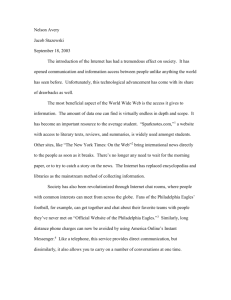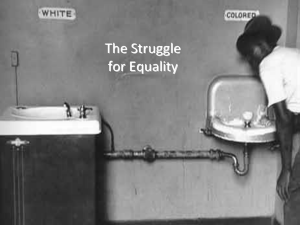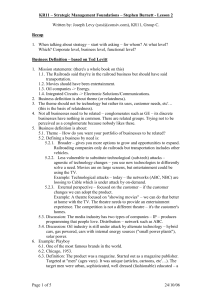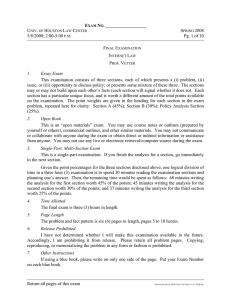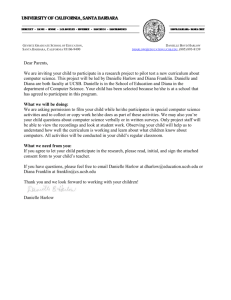E A C
advertisement
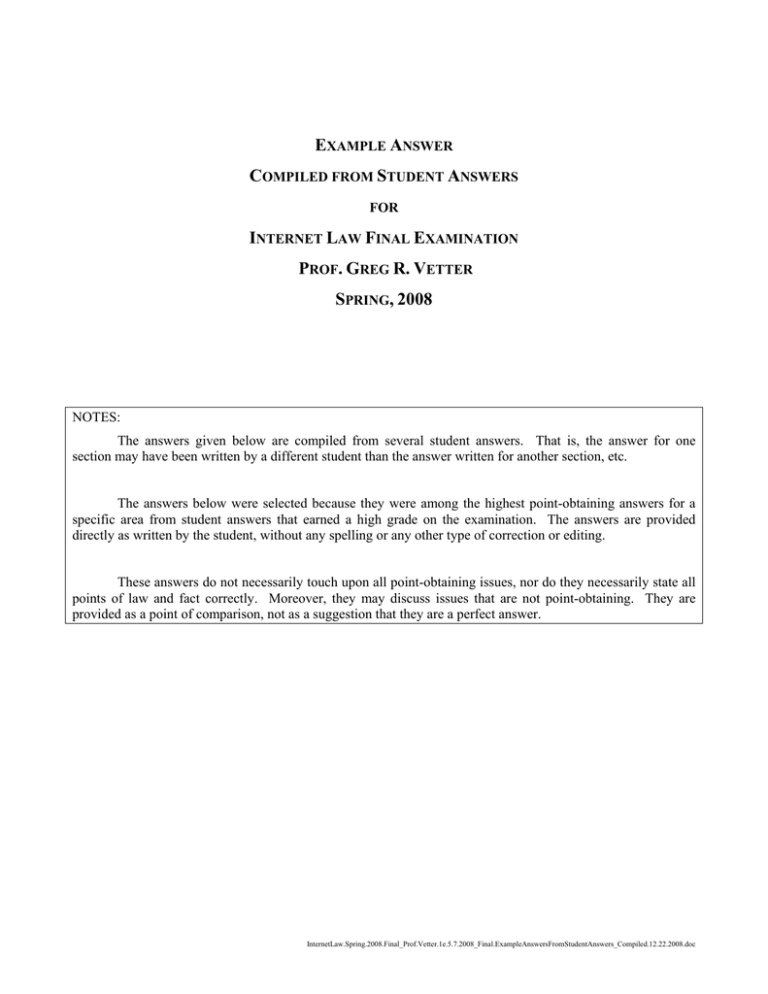
EXAMPLE ANSWER COMPILED FROM STUDENT ANSWERS FOR INTERNET LAW FINAL EXAMINATION PROF. GREG R. VETTER SPRING, 2008 NOTES: The answers given below are compiled from several student answers. That is, the answer for one section may have been written by a different student than the answer written for another section, etc. The answers below were selected because they were among the highest point-obtaining answers for a specific area from student answers that earned a high grade on the examination. The answers are provided directly as written by the student, without any spelling or any other type of correction or editing. These answers do not necessarily touch upon all point-obtaining issues, nor do they necessarily state all points of law and fact correctly. Moreover, they may discuss issues that are not point-obtaining. They are provided as a point of comparison, not as a suggestion that they are a perfect answer. InternetLaw.Spring.2008.Final_Prof.Vetter.1e.5.7.2008_Final.ExampleAnswersFromStudentAnswers_Compiled.12.22.2008.doc INTERNET LAW EXAMINATION, 2008 EXAMPLE ANSWER COMPILED FROM STUDENT ANSWERS A. Section A ACPA Domain Name Analysis: The UDRP analysis is not binding on a court that examines a matter under the ACPA. However, the court should take note that the UDRP arbitration panel held that Danielle used or registered the domain names in bad faith. Under the ACPA, a person is liable to the owner of a mark when they (1) have a bad faith intent to profit from that mark; and (2) register, traffic in, or use a domain name that is (a) identical or confusingly similar to a distinctive mark; or (b) identical, confusingly similar to, or dilutive of a mark for famous marks. Remedies under the ACPA can include actual damages from lost profits, statutory damages, and/or injunction. Additionally, the domain name can be transferred to the mark owner or cancelled. The courts have used a 9-factor test to evaluate bad faith. The nonexclusive 9 factors include: (1) IP rights in the domain name; (2) extent that the domain name is used to identify a person; (3) offering of goods or services; (4) Intent to divert consumers from a goodwill site; (5) Offer to sell without a bona fide first use; (6) misleading contact information when applying for a domain name; (7) hording multiple domain names, knowing they are similar to others; (8) the extent to which a mark is distinctive or famous; and (9) non-commercial or fair use of the mark. In applying the ACPA test to Danielle, the court must first determine if she had a bad faith intent to profit from a domain name. The court will apply the 9-factor test to determine the extent of bad faith. Several factors are a non-issue in the present case: the domain name is not used to identify a person and there is no offer to sell something w/o a bona-fide first use. Factors that weigh against a finding of bad faith include her registration of the domain names using the correct contact information and a possible fair-use of the mark by a former playmate. The factors supporting a finding of bad faith intent to profit include: the IP rights of Playboy in the domain name Playboy.com, the fact that Danielle re-sells used copies of the Reeling in Fortune board game through her website, a possible intent to divert web users to her website from the playboy.com site by using a common mistyping of playboy, the similarity between the way playboy and playbot sound when spoken aloud, the hording of multiple TLDs with playbot as the main catch word, and finally the fact that the playboy mark is likely both distinctive and famous. These factors tend to favor the notion that Danielle is acting in bad faith in her choice of playbot for her website. The next step for the court is to determine if the domain name is identical, confusingly similar, or dilutive of the mark. We will assume that playboy is a famous mark for this analysis, since it is well known. It is clear that playboy and playbot are not identical. To analyze whether a mark is confusingly similar to another mark, the court will apply a test for the likelihood of confusion. This 8-factor test examines: (1) the strength of the mark; (2) the proximity of the goods to others in the marketplace; (3) the similarity of the marks; (4) evidence of actual confusion; (5) marketing channels used; (6) type of goods and degree of care associated with the average consumer; (7) defendant's intent in selecting the mark; and (8) likelihood of expansion of product lines. In applying a likelihood of confusion test the court attempts to examine the likelihood that a consumer would be confused as to the source of goods or services: the likelihood that a consumer would believe that Danielle's page was sponsored or otherwise approved by playboy. 1 InternetLaw.Spring.2008.Final_Prof.Vetter.1e.5.7.2008_Final.ExampleAnswersFromStudentAnswers_Compiled.12.22.2008.doc INTERNET LAW EXAMINATION, 2008 EXAMPLE ANSWER COMPILED FROM STUDENT ANSWERS The strength of the playboy mark is at minimum suggestive although possibly arbitrary or fanciful. The proximity of the goods in not a relevant inquiry for the present case, outside of the fact that both of the "goods" playboy.com and playbot.com share the same marketplace niche. The marks are very similar--they sound alike, differ by a single letter in spelling, and can easily be mistyped using a keyboard. There is no evidence of actual confusion--playbot probably does not have many pictures of naked women on the site, since it is a gripe site about mistreatment of women. The marketing channels appear to be the same for playboy.com and playbot.com--the internet. Playboy, however, also has a print magazine, which playbot does not have. The degree of care of the average consumer would make a consumer seeking an actual playboy site with pictures likely to not be confused or mislead by the playbot site. Danielle's intent in selecting the playbot name could certainly be considered questionable and possible done in bad faith to profit from others mistyping playboy. Finally, the websites don't seem to have much conflict if there is any likelihood of expansion of either site or their products. Thus, a court could conclude that the playbot domain name is confusingly similar to playboy. If the playboy mark is indeed considered to be famous, and the court had yet to find a likelihood of confusion, then the next analysis would be trademark dilution. Famous trademarks are protected from dilution by others that would use marks that are similar enough to dilute the distinctiveness of a famous mark. Dilution can either involve a blurring of distinctiveness or a tarnishment of image. However, fair uses such as advertising, commentary, product comparison, parody, and criticism are excluded from trademark dilution. In the present case, the court could find that Danielle's use of playbot served to blur the distinction between playboy and playbot. Alternatively, the court could find that Danielle's gripe site about the exploitation of women actually hurts the sale of playboy magazine, and therefore serves to tarnish playboy trademark. Trademark Infringement: Trademark infringement involves the use of products in commerce with likely consumer confusion as to the source of goods. Initial interest confusion is a form of infringement where an infringer capitalizes on the goodwill associated with a registered trademark. The court has held that using a registered trademark belonging to another company in your metatag is an example of initial interest confusion. Brookfield v. West Coast. Additionally, the courts hold that search engines that use keyword databases that include trademarked terms that will appear with other, unrelated goods and services is also initial interest confusion. Playboy v. Netscape. The general rule from the courts is that you cannot make a bad faith attempt to trick users into visiting your website by using the trademarks of others when they are searching for another's website, including through the use of metatags. Bihari v. Gross. Analysis for initial interest confusion uses the same 8-factor test for likelihood of confusion, as detailed above. IN applying these factors, we see that Danielle has directly used the trademark playboy in her metatags and keywords. The mark is distinctive, the mark is copied identically, the marks are the same words so they sound, look, and mean the same things, the mark would be found exclusively through internet searches, and Danielle likely intentionally used the playboy mark to direct traffic to her website. 2 InternetLaw.Spring.2008.Final_Prof.Vetter.1e.5.7.2008_Final.ExampleAnswersFromStudentAnswers_Compiled.12.22.2008.doc INTERNET LAW EXAMINATION, 2008 EXAMPLE ANSWER COMPILED FROM STUDENT ANSWERS Click Fraud: Common law fraud has four elements: material false statement, intent to deceive, reasonable reliance, and damages. One of the newer forms of online fraud is called click fraud and involves bad faith clicks on advertisments so that the website operator will in turn be paid advertising revenue on a perclick basis. In conducting her Kumbaya chat room, Danielle instructs her friends to repeatedly click on the advertisements on her website so that she can generate revenue. Apparently, playbot.com has many pay-per-click advertisements on its website. In the present case, Danielle's activities and those of her co-horts amounts to click fraud. It involves a material false statement with an intent to deceive: faking a genuine interest in the advertised product, following the link, and then repeating the process. The advertisers reasonably rely on the web host to not condone or encourage such activities, and the advertisers also rely on the fact that each click is a real advertsing "hit." Finally, damages are the payments made by the advertisers to Danielle for the fraudulent traffic originating from her website. Copyright Infringement: Copyright protection includes the sole right to reproduce and distribute your copyrighted materials, among other rights. Infringement is anyunauthorized reproduction or distribution, unless done in fair use. In the present case, Danielle has digitally scanned a 3-page article that is copyrighted material owned by Playboy. This amounts to a reproduction. Danielle has additionally posted this article on her website, thereby reproducing the digital file at least once more in the transmission to and storage by the website host. Additionally, courts may conclude that posting the copyrighted material on a public website is public display of the copyrighted material, an additional act of infringement by Danielle. Therefore, Danielle could likely be found guilty of copyright infringement on several counts for infringing copyrighted Playboy material. Gripe Sites: Danielle website is dedicated to commentary about how modern media robotizes women. In this light, the website could be considered a gripe site. Trademarks can be used in a nominative sense when there is no good alternative description for the trademarked item. The nominative use defense to trademark infringement requires (1) that products/services cannot be readily identied without the mark; (2) that the smallest possible portion of the mark is used; and (3) that the user of the mark cannot suggest endorsement by or sponsorship from the mark owner. Additionally, the First Amendment grants the right to use another's trademark as a part of free speech in a communicative message, so long as the speec is not used to identify the source of the product. In the present case, Danielee could certainly argue that her website is a gripe sit and that all the uses of the term playboy are nominative use. The court has held that former playmates were allowed to use the playboy name in metatags and banners on their websites. Playboy v. Welles. Thus, Danielle could argue that her use of Playboy in her metatags and keywords are nominative fair use and are only incidental to the function of her site. The words serve to identify her as a 3 InternetLaw.Spring.2008.Final_Prof.Vetter.1e.5.7.2008_Final.ExampleAnswersFromStudentAnswers_Compiled.12.22.2008.doc INTERNET LAW EXAMINATION, 2008 EXAMPLE ANSWER COMPILED FROM STUDENT ANSWERS former playmate, which cannot be readily done without the use of the playboy trademark. Additionally, only the word playboy was used, while the logo was not--therefore, Danielle attempted to use the smallest portion of the logo possible. Jurisdiction: State Tort Law Claim: Danielle's website is more than a passive repository of information: it contains a page that allows her to re-sell used copies of the Reeling in Fortune board game. The transaction is completed using a credit card processor in OK. Additionally, Danielle custom wraps the game in her own packaging. The repackaging of the game can be considered a tortious injury in OK. For personal jurisdiction, 2 general types exist. The first is specific contacts where the action arises out of the actual but limited contacts of the defendant who has purposefully availed themselves to the state, the action arises out of contacts with the state, and being haled into court in the state is reasonable and fair. The second is general contacts, where jurisdiction in the state is established by the continuous and systematic contacts of the defendant with the state. In the present case, Danielle does not have a continuous and systematic presence in the state, so the only possibility is specific contacts. The long-arm statute for OK states that accessing a computer within the state is considered an act within the state. Therefore, Danielle's sending of data and processing the data using a computer in OK likely gives the state long-arm jurisdiction. The courts have given 3 categories of jurisdiction for internet contacts: (A) where D clearly does business over the internet w/ residents of a foreign local, which always creates personal jurisdiction; (B) whwere D only provides passive information, which never creates personal jurisdiction; and (C) where interactive websites exchange some information, which sometimes creates personal jurisdiction. In the present case, and given the OK long-arm statute, Danielle's actions fall into category (A), since she clearly is doing business within the state of OK by using computers in OK to process her data. 4 InternetLaw.Spring.2008.Final_Prof.Vetter.1e.5.7.2008_Final.ExampleAnswersFromStudentAnswers_Compiled.12.22.2008.doc INTERNET LAW EXAMINATION, 2008 EXAMPLE ANSWER COMPILED FROM STUDENT ANSWERS B. Section B FTC In BJ's Wholesale Club, the FTC alleged that the BJ's failed to employ reasonable measures to safeguard its customer's credit card information. Here, not only did D fail to employ reasonable measures to safeguard her customer's personally identifiable information (PII), but she actually sold it to others. However, there does not appear to have been any privacy policy implemented by D for her website. The FTC forbids violations... Copyright infringement with regard to the music Here, there are 2 copyrights at issue: 1)the musical work "Time in the Mansion" and 2)the sound recording by the Heffner singers. By her actions (streaming the music on her website), D has made a reproduction and performance of both works. However, if she has paid the appropriate license fees, she will not be liable for copyright infringement. Since she performed the musical work under conditions qualifying for the compulsory mechanical license and paid license fees for the internet broadcast of the musical work, she may be protected with regard to the musical work. She also paid for the compulsory license of the DTPR for the sound recording. However, nothing in the facts shows that she has protected herself with regard to the reproduction she made of the sound recording. Since she has made a reproduction of the sound recording (at the very least by the copy made by her computer when it loads into RAM), she has violated P's reproduction right in the sound recording by the Heffner Singers. D will attempt to claim fair use. The factors to conisider for fair use are 1)the purpose and character of theuse, 2)the nature of the copyrighted work, 3)the amount and substantiality of the portion used in relation to the work as a whole, and 4)the effect of the use upon the potential market for or value of the copyrighted work. Here, D will claim that the use was non-commercial, but will likely fail because it is more likely that the use would be considered commercial because it made the user's visit to the site more enjoyable, perhaps prompting the user to purchase from D. The nature of the work factor also goes against D because this work is the core of copyright (creative rather than factual in nature). The entire work was used, so this also weighs against a finding of fair use. The effect on the market in this case is difficult to measure, but it could be said that, because the song continued to play on a loop, a user could just go to D's site whenever they wanted to hear it, rather than purchasing from D. All of these factors weigh against a finding of fair use. Copyright infringement with regard to the software add-in For secondary liability under copyright infringement, there can be 1) contributory liability, 2)vicarious liability, or 3)inducement. It appears that inducement is at issue here. Under the Grokster case, one who distributes a device with the object of promoting its use to infringe copyright is liable for the resulting acts of infringement of 3rd parties. Here, D has obviously distributed the add-in for web browsers. D will argue that 1) her device is capable of substantial non-infringing use and 2) there is no evidence that she actually induced infringement. Even 5 InternetLaw.Spring.2008.Final_Prof.Vetter.1e.5.7.2008_Final.ExampleAnswersFromStudentAnswers_Compiled.12.22.2008.doc INTERNET LAW EXAMINATION, 2008 EXAMPLE ANSWER COMPILED FROM STUDENT ANSWERS though it is true that her device is capable of substantial non-ifringing use (because about 1/3 of the material discovered by the add-in is infringing -- indicating that 2/3 is not), D can still be liable if her actions show sufficient intent to cause infringement. Here, it appears that the add-in was designed to facilitate specialized internet searching for images from Playboy's magazine or online materials (which appears to be infringing activity, as the reproduction right is violated by the user when they access such images online). D will argue, however, that she uses a filter to check against a blocking list and that her site contains a warning against downloading infringing material. However, the fact that she waits 2 months after receiving notice to place links on her blocking list indicates bad intent. Further, her original estimates of the rate of infringement that she knew of before she created that add-in (75-90%) also shows bad intent on her part. D will also claim that she is covered by 512(d), which limits liability of a service provider who is engaged in the activity of "referring or linking users to an online location containing infringing material or infringing activity by using information location tools, including index, reference, pointer, or hypertext link..." To qualify, the service provider 1)must not have knowledge of the infringement, 2)must not be aware of facts from which infringement is apparent, or 3)upon obtaining such knowledge, he must act expeditiously to remove or disable access to the material. Further, if he has a right to control the infringing activity, he must not receive direct financial benefit from the activity. Finally, if he receives certain notice, he must remove or disable access to the infringing material or activity. Here, the main factor weighing against D is the fact that she waits too long after receiving notice under 512c3. Therefore, she does not act expeditiously to disable access to the infringing material. THerefore, she cannot gain the benefit of limited liability under 512d. 6 InternetLaw.Spring.2008.Final_Prof.Vetter.1e.5.7.2008_Final.ExampleAnswersFromStudentAnswers_Compiled.12.22.2008.doc INTERNET LAW EXAMINATION, 2008 EXAMPLE ANSWER COMPILED FROM STUDENT ANSWERS C. Section C Smith, as Laudon, is likely concerned with the extremely low cost of personal information online. Laudon believes that, by making the personal information the property of the person to whom it refers, the cost of such information will not be so low and therefore will not be so widely marketed. Smith's approach to implement this belief, however, will not necessarily achieve the result he desires. Particularly, the WTS is nothing more than a statement and does not actually place the property right in the information with the individual. To achieve this result in a more concrete way, he should require the websites themselves to adopt policies with regard to personal information that they would be required to abide by (that would detail the precise ownership interests and alienability, if any, of such rights). This would make it such that the websites would be more likely to be bound. The alienability of the ownership of the personal information is important to consider in this context. Specifically, as mentioned by Litman, if the ownership right in the information is placed with the person to whom it refers, that merely means that such ownership is only with that person until they somehow trade it away. Under Smith's proposal, the mere statement that the person is the owner of the information does not make the information inalienable, and the savvy website operator would likely see this as an opportunity to become the owner of the personal information through any transaction with the operator (by, say, clicking something that says "I agree to transfer my personal information as consideration for the purchase of X"). As Litman points out, such a system would actually legitimize the market for personal information, which is what Smith wants to protect against. By requiring the websites to adopt and adhere to a policy whereby they agree not to purchase or acquire personal information, we could more readily prevent alienability. Another important consideration is whether Smith wants to protect against the acquisition by companies of personally or nonpersonally identifiable information. There seems to be an important policy difference between the two, and it is unclear what Smith's stance is on the issue. People in general would likely be much more accepting of the collection of non-personally identifiable information, and he may have a better chance of seeing the results he desires if he focuses his efforts on the collection of personally-identifiable information. With regard to the FTC advertisement, this is a fine idea. It seems like a very good idea to empower the public with the ability to assert ownership over their personal information, particularly if the statement were refined to address the issue of PII vs nonPII. The contrary position to all of this, of course, is the argument that collection of personal information by companies leads to efficiency (because companies would be able to focus advertising on those people who most likely want the products). The theory would be that the overall cost of goods to the public would be lessened because marketing dollars would not be wasted by casting a broad advertising net in the hopes of reaching the desired market. Despite this, something needs to be done to at least limit the collection and trade of personal information (especially PII) because the privacy concerns certainly outweigh the economic considerations. 7 InternetLaw.Spring.2008.Final_Prof.Vetter.1e.5.7.2008_Final.ExampleAnswersFromStudentAnswers_Compiled.12.22.2008.doc

